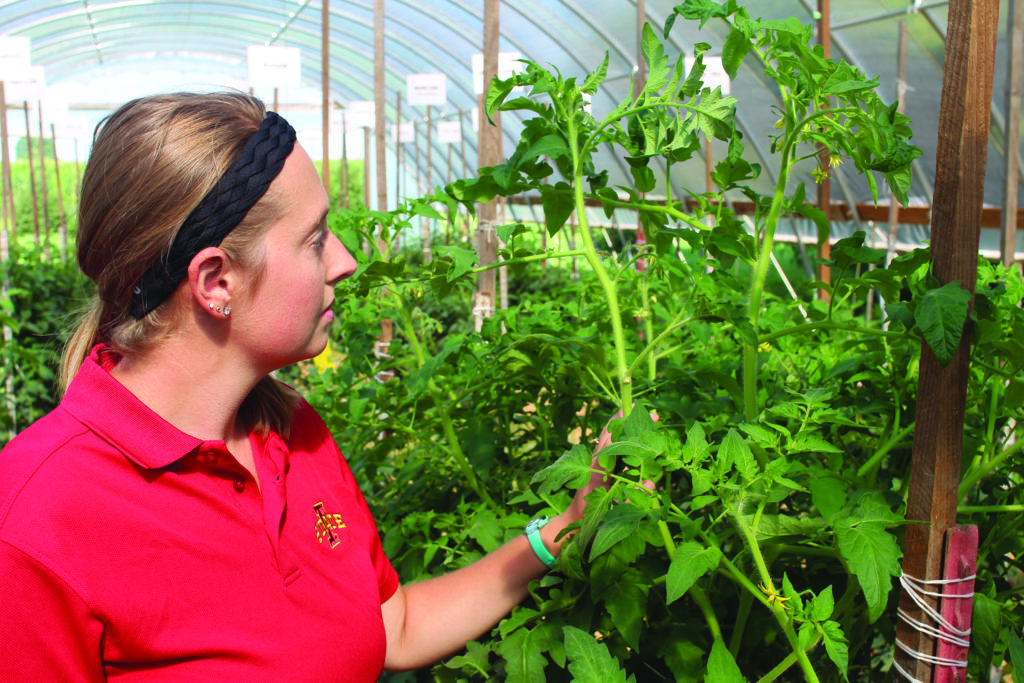

Nov 15, 2018Assessing tomato grafting in low-disease high tunnels
Grafting is a proven way to incorporate disease resistance into tomato transplants. But in areas of the country with less history of tomato production and less soil-borne disease, is grafting still beneficial?
“Are there suitable rootstocks that can increase tomato production efficiency and quality for Iowa and other parts of the Midwest?” asked Ajay Nair, associate professor in Iowa State University’s (ISU) Horticulture Department. “What rootstocks are the best if a Midwestern grower is going to graft tomatoes?”
“We haven’t been growing tomatoes in high tunnels for very long,” said Kristine Lang, graduate student and researcher in ISU’s Horticulture Department. “In the absence of tomato diseases, does grafting still have a benefit for Midwest tomato growers?”
Early indications of new ISU research is that grafting is still beneficial – as long as growers select the right rootstocks.
ISU’s research on tomato rootstocks in high tunnels with low disease pressure was recently presented at the American Society for Horticultural Science annual meeting in Washington, D.C.
Initial rootstock research at ISU evaluated the results of grafting the RST-04-106-T rootstock onto the tomatoes Cherokee Purple and Mountain Fresh Plus in a high tunnel that didn’t have a history of tomato production. Cherokee Purple is an indeterminate type of tomato and Mountain Fresh Plus a determinant type. “We wanted to see if grafting made any difference under our disease-free conditions,” Nair said.
Grafting produced a slight increase in the number of marketable fruit, but not in the total pounds of production. “We didn’t have any real incidence of soil-borne diseases in the high tunnel so we thought that might be why grafting was not highly beneficial,” Lang said.
Follow-up research expanded the number of rootstocks being evaluated to include Arnold, Beaufort, Estamino, Maxifort, RST-04-106-T, DRO141TX, and 946_TRS and 980_TRS. The rootstocks were grafted onto the scion BHN 589.
“Arnold, Beaufort, Estamino and Maxifort are well-established rootstocks,” Nair said. “Most of the rootstocks we’re trying have been tested and shown promise in other states.” DRO141TX is a new rootstock and 946_TRS and 980_TRS are experimental lines.
The number and weight of marketable fruit per plant were collected from weekly harvests during early July to late September in 2017. Fruit quality, including total soluble solids (Brix) and acidity, were measured at peak production in August. The leaf chlorophyll content and the nitrogen and potassium levels in the petiole sap were measured during the growing season. Plant height and aboveground dry weight were measured at the end of the season.
Arnold, Beaufort, Estamino, Maxifort and DRO141TX emerged as the better-performing rootstocks in the study. “These are emerging as higher yielding, with good quality, and this is in a soil with a near absence of disease,” Lang said. “These five highest-yielding rootstock combinations also had the five highest biomasses.”
In ISU’s 2018 trial, seeding dates ranged from Feb. 26 to March 3 with grafting on March 20. A seeding plan like this ensures stems are a similar size when grafting occurs since some rootstocks germinate and grow quicker than others. “We’d encourage growers to do a germination trial to assess the germination time and growth potential of their rootstocks,” Lang said.
Transplant size, stem size, and the proper healing of graft unions are all important to grafting success – as is proper sanitation. “It’s clean seed, clean hands and a clean soil medium,” Lang said.
This all translates into grower training and education to produce healthy, grafted plants.
“Have some idea of the research on the rootstock,” Nair said. “Accessibility is an issue although most of these rootstocks are readily available. Price will always be an issue as will quality. Growers should only buy from reputable seed sources.”
“What diseases do you have?” Lang asked. “Pick a rootstock that works for you. Make sure it aligns with the problem you have.”
The site www.vegetablegrafting.org is a good source of research-based rootstock information. It has good numbers on the vigor of various rootstocks. The site is part of the Specialty Crops Research Initiative Vegetable Grafting Project. The project coordinates the work of researchers at 10 U.S. universities with the USDA Horticultural Research Laboratory in Fort Pierce, Florida.
The Ohio State University’s Vegetable Production Systems Laboratory has seedling vigor ratings of many common tomato rootstocks plus other useful information on grafting. The laboratory can be accessed at u.osu.edu/vegprolab/research-areas/grafting-2.
“Try grafted tomatoes on a small scale,” Lang said. “Do a small study in your field or in your high tunnel. Try 10 plants with a single rootstock, or compare a few rootstocks, and see if tomato yield and quality pencils out for you.”
“High tunnels can extend the growing season – both into the spring and into the fall, get more yield and improve quality,” Nair said. However, disease build-up, soil fertility and salinity issues, the need for irrigation, limited space and ultimately higher input costs are challenges.
“Rootstocks may have a big impact on how plants grow and can help with some of these challenges,” Nair said. “Learn all you can and pay attention to your rootstocks.”
– Dean Peterson, VGN Correspondent
Above: Kristine Lang is a graduate student and researcher in Iowa State University’s Horticulture Department. Photo: Dean Peterson














